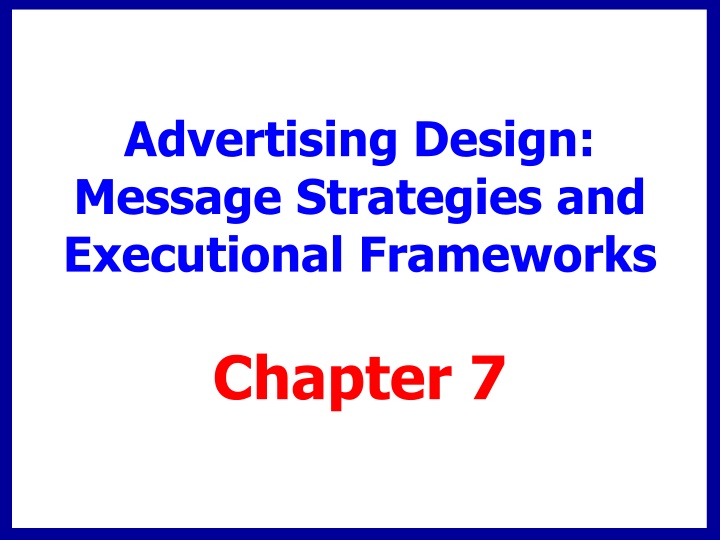Effective Advertising Message Strategies and Executional Frameworks
Exploring message strategies and executional frameworks in advertising, this chapter covers cognitive, affective, and conative approaches. It delves into the use of spokespersons and endorsers, principles of effective advertising, and various strategies like generic, preemptive, and comparative. Additionally, it discusses the Hierarchy of Effects Model and how it influences awareness, knowledge, liking, preference, conviction, and actual purchase decisions.
Download Presentation

Please find below an Image/Link to download the presentation.
The content on the website is provided AS IS for your information and personal use only. It may not be sold, licensed, or shared on other websites without obtaining consent from the author.If you encounter any issues during the download, it is possible that the publisher has removed the file from their server.
You are allowed to download the files provided on this website for personal or commercial use, subject to the condition that they are used lawfully. All files are the property of their respective owners.
The content on the website is provided AS IS for your information and personal use only. It may not be sold, licensed, or shared on other websites without obtaining consent from the author.
E N D
Presentation Transcript
Advertising Design: Message Strategies and Executional Frameworks Chapter 7
Chapter Overview Message strategies Executional frameworks Spokespersons and endorsers Principles of effective advertising
Message Strategies Cognitive Affective Conative
Message Strategies Cognitive Affective Conative Generic Preemptive Unique Selling Proposition Hyperbole Comparative
Generic Cognitive Message An ad for Koestler Granite & Marble using a generic cognitive message strategy. Click picture for video.
Preemptive Cognitive Strategy An ad for the Waterfront Grill created by Sartor Associates using a pre-emptive cognitive message strategy. Click picture for video.
Comparative Cognitive Strategy Direct or indirect comparisons Real or fictitious competitor Captures attention Brand awareness increases Message awareness increases Choose comparisons carefully Less believable, negative attitude
Message Strategies Cognitive Affective Conative Resonance Emotional
Resonance Affective Strategy Advertisement by Cheerios using a resonance, affective message strategy.
Message Strategies Cognitive Affective Conative Action-inducing Promotional support
Message Strategies Hierarchy of Effects Model HEM Message Strategies Awareness Knowledge Liking Preference Conviction Actual purchase Cognitive strategies Affective strategies Conative strategies Brand strategies
Executional Frameworks Animation Slice of life Dramatization Testimonial Authoritative Demonstration Fantasy Informative
Executional Frameworks Animation Originally used by firms with small advertising budgets. Increased use due to advances in computer technology.
Executional Frameworks Slice of Life (Dramatization) Encounter Problem Interaction Solution
Executional Frameworks Testimonials Business-to-business ads Service sector Enhance credibility Source Customers Paid actors
Executional Frameworks Authoritative Expert, Scientific or survey authority Independent evidence Business-to-business ads Cognitive processing Specialty print media
Executional Frameworks Demonstration Shows product use Business-to-business sector Video/TV/Internet
Executional Frameworks Fantasy Beyond reality Common themes Sex, Love, Romance Products such as perfume/cologne/personal grooming
Executional Frameworks Informative Used extensively in radio Business-to-business usage Key is buying situation Level of involvement
Spokespersons Celebrities CEOs Experts Typical persons
Source Characteristics Attractiveness Trustworthiness Similarity Expertise Likeability Credibility
Source Types and Characteristics Celebrities Tend to score high in credibility Over exposure, Negative publicity CEO Trustworthy, expertise, and some credibility Must exercise care in selection Expert Seek experts who are attractive, likable, trustworthy Valid credentials important Typical person Real-person, Actor 7-22
Principles of Effective Advertising Visual consistency Campaign duration Repeated tag lines Consistent positioning Simplicity Identifiable selling point Effective flow























